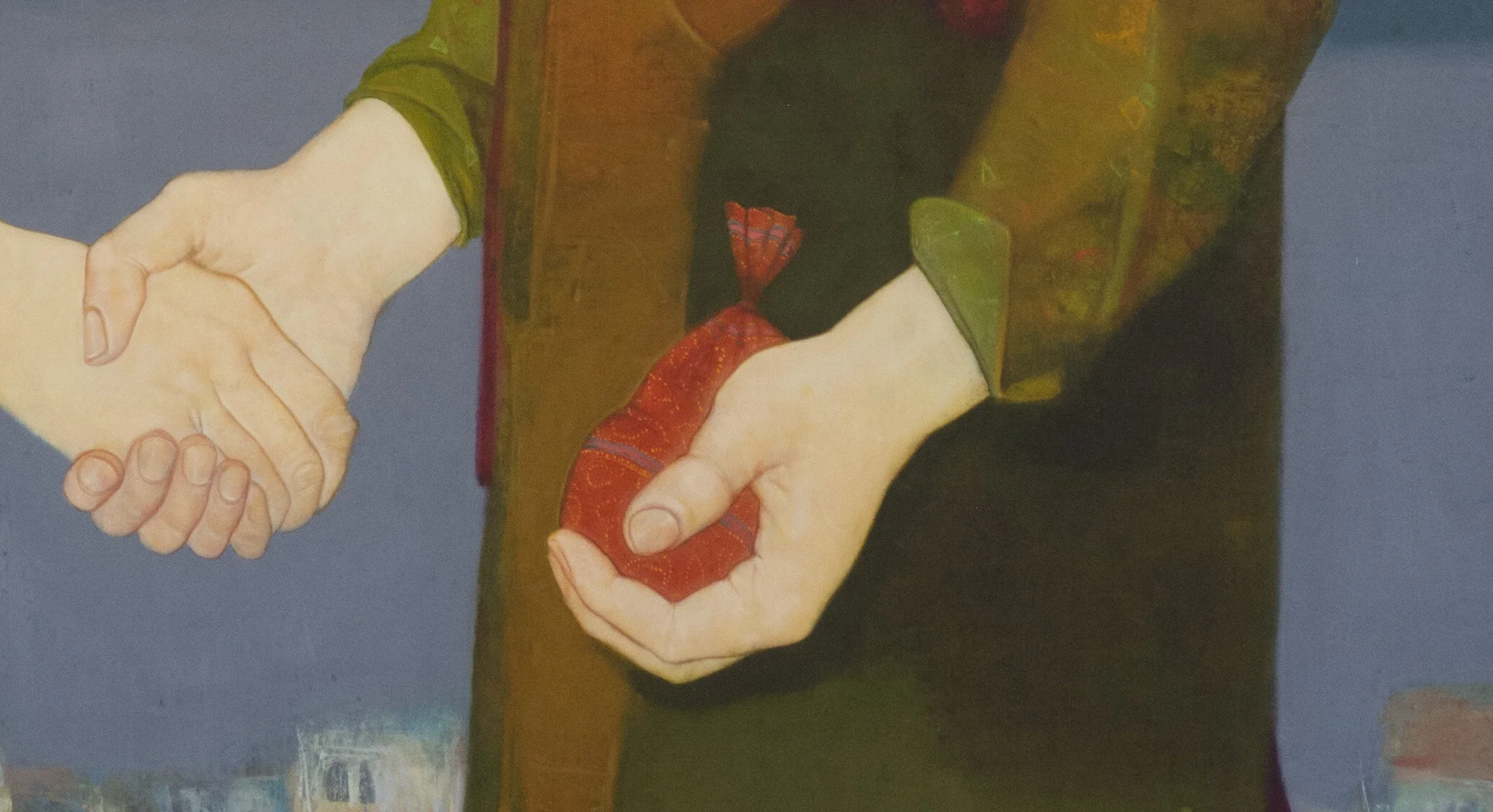THE DEAL
Mamuka Dideba, The Deal, 2016, oil on canvas, 150 x 100cm, private collection
“Mamuka Dideba’s paintings are populated by magical characters inhabiting wondrous worlds in-between time and space.
Each artwork is a story. Let’s begin our exploration with The Deal. The premise seems simple, right? The real meaning may surprise you.”
“Set against a cityscape, two figures are exchanging a key for a bag of coins. Our first impression is not positive. ”
“Keys are a symbol of power. Over centuries of wars, our minds instinctively react with dread upon seeing an exchange set against the backdrop of a city. It immediately evokes a change of power, a capitulation to a conqueror - usually after heavy losses on both sides.”
Diego Velazquez, The Surrender of Breda, 1634-35, oil on canvas, 307 x 367cm, Museo del Prado, Madrid, Spain
The Surrender of Breda, detail
“One famous painting immediately springs to mind.
The Surrender of Breda” (aka “The Lances”) by Diego Velazquez, exquisitely depicts the conquest of Breda in the name of Philip IV in the 17th century. Here, Velazquez portrays Justinus van Nassau, the leader of the exhausted Dutch, surrendering the key to the city to the magnanimous and almost fatherly victor, the Spanish General Spinosa, whose superior military strength is underscored by the raised lances behind him. ... In fact, few Dutchmen and even fewer Spaniards survived the siege of the city.”
Mamuka Dideba, The Deal, detail
“Of course, as the Bible reminds us, keys symbolise access to things not only physical but also spiritual and the giving of a key may be the greatest gift, borne out of love, not conquest.”
Pietro Perugino, The Delivery of Keys, c. 1481-1482, fresco, 330 x 550cm, Sistine Chapel, Vatican City, Rome
The Delivery of Keys, detail
“The Delivery of Keys” by Pietro Perugino, the Renaissance painter and Raphael’s teacher, elegantly illustrates a scene from Matthew 16 where Christ gives “the keys of the kingdom of heaven” to Saint Peter. Here, the keys are an instrument of good - the power to forgive, to ascend spiritually, and to help others do so.”
“If you compare the relationship of the figures, you will see that whereas in Velazquez’s “The Surrender of Breda” the Dutch bow before the Spanish and in Perugino’s “The Delivery of Keys” Saint Peter kneels before Christ, in Dideba’s “The Deal” the figures are equals.”
“All right then, you might say, Dideba’s characters are equals and maybe the key has a positive meaning. But what does the bag of money have to do with it?
Without descending into the mundane where real estate and the keys thereto are bought and sold for money, it is unusual to see a painting depicting such an exchange without the slightest hint of treachery or anything untoward.”
Mamuka Dideba, The Deal, detail
“This brings us to a philosophy dear to Dideba’s heart.
The painting references Apollonian and Dionysian dichotomy best known from Nietzsche’s 1872 book “The Birth of Tragedy”. In Greek mythology, Apollo and Dionysus are both sons of Zeus, the Ruler of all Gods. Apollo governs reason, form and structure (analysis) whereas Dionysus governs ecstasy, emotions, and intoxication (instinct). The Greeks considered these gods as two sides of one whole. Likewise, Nietzsche argued that the presence of both rationality and instinct is imperative in the creation of the arts.”
“For Dideba, the key is Apollonian. The painting is not religious and the key represents ownership of a physical thing. Through reason and analytical thinking people use possessions, such as cars or houses, as rational expressions of their form and individuality. There is no judgment here - possessions are simply an expression of our Apollonian side, they are neither good nor bad.”
“The pouch with money is Dionysian. Money can be used in the heat of the moment, with great abandon, thrown about in gambling or bars, or spent on an impulse buy of some widget so conveniently placed by your side as you wait at the checkout line in the supermarket.”
“Apollonian reason and Dionysian emotions are part and parcel of one whole. In joining together Dideba’s figures create balance. Interestingly, Dideba subconsciously arranges the key and money elements in the configuration of Yin and Yang, the Chinese philosophy of dualism.”
“The characters in “The Deal” complete each other. It is no wonder that such good will and kindness emanate from their faces.”
“There is much more to this painting, more magic hidden in the composition of the city, the whimsical costumes of the figures, and even the facial details. But one story at a time.”
A message of hope from Mamuka Dideba
MAMUKA “DIDEBA” DIDEBASHVILI’s art is a unique expression of the wonder, subtle humour, and the often surreal and warm philosophical outlook that is quintessential of the small but wondrous country of Georgia where he lives and works.
A rare master of the figurative and the abstract, Dideba paints in exquisite Renaissance imprimatura technique that lights up the canvas from within. This process requires enormous skill and patience and is the same technique used by Leonardo da Vinci.
Inspired by the Old Masters, Dideba creates nuanced characters who seem to walk off the canvas while remaining fixed in their own world, at an indeterminate time and place. Dideba completes a painting only when he senses the figure is alive, as if about to start a conversation.
Born in 1968 in Tbilisi, the capital of Georgia, Dideba studied at the prestigious Nikoladze School of Art and the Tbilisi State Art Academy. Dideba is known as “Georgia's Bruegel” because of his deviation from realistic proportions and interest in human behaviour.
Widely exhibited internationally, Dideba’s work was shortlisted for the Royal Academy of Arts Summer Exhibition. His first solo exhibition in London was with Katrine Levin Galleries at Shapero Modern in Mayfair, in 2019.




















